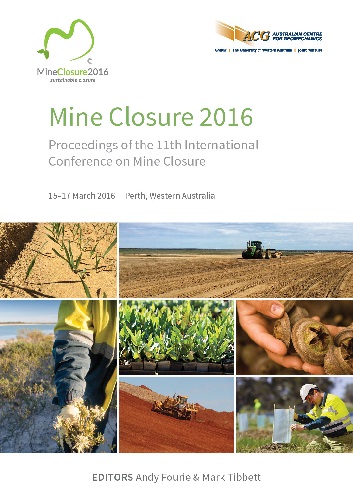Social closure planning: scoping, developing and implementing – a case study

|
Authors: Heymann, EF; Botha, PR; Grant, CD; January, M |
DOI https://doi.org/10.36487/ACG_rep/1608_14_Heymann
Cite As:
Heymann, EF, Botha, PR, Grant, CD & January, M 2016, 'Social closure planning: scoping, developing and implementing – a case study', in AB Fourie & M Tibbett (eds), Mine Closure 2016: Proceedings of the 11th International Conference on Mine Closure, Australian Centre for Geomechanics, Perth, pp. 213-227, https://doi.org/10.36487/ACG_rep/1608_14_Heymann
Abstract:
Social aspects often lag behind or are not factored into closure plans with the same rigour and levels of confidence as the physical and bio-physical aspects. Anglo American has a predominance of operations in developing countries where local communities become directly and indirectly dependent on the mining activities for their livelihoods. This emphasises the importance of proactive management of social aspects throughout the life-of-mine and at closure. Anglo American is of the opinion that a mine closure plan without concurrent social planning leaves a significant gap in the planning process, lowers the overall confidence in sustainable closure and increases post-closure residual risk as well as associated liabilities. The objective of this case study is to demonstrate how the Anglo American Mine Closure Team is assisting a coal mine in South Africa to develop its social closure plan and closure costs for the site. This is a significant departure from the norm where operations in the past have used external consultants. Using in-house resources ensures deeper ownership of the mine closure plan and thus a better chance that the plan will be executed as intended. The final social closure plan will address the needs and risks associated with employees and dependents, interested parties, affected parties and regulators. Understanding the needs and expectations of these stakeholders is essential to improve the confidence of the overall mine closure plan. The project to develop the social closure plan is split into three phases. The objective of phase one is to deliver a detailed scope of work, with actions, timelines, accountabilities and budgets, which will inform the development of the social closure plan component of the overall mine closure plan. The objective of phase two is to support the colliery with the execution of the actions identified in phase one to ensure the social closure plan is compiled to an acceptable level of confidence given the closure date for the colliery and that it is delivered within set timelines and budgets. The objective of phase three is to support the colliery to implement the social closure plan over the remaining life-of-mine and improve the level of confidence of the final closure plan, mainly through increased stakeholder engagement. Social closure criteria will be developed and included in the current stakeholder engagement platforms. The development of the social closure plan is managed as a project where gaps are identified, all required activities are mapped, resources assigned, critical paths identified and where the schedule is managed with rigour. Through this approach the challenge of involving a diverse array of internal and external stakeholders is much easier to manage. In addition, this multi-disciplinary approach allows for better integration and synergies between the social, physical, biophysical and financial closure planning.
Keywords: social closure planning, stakeholders, integration, project management, sustainable closure
References:
Anglo Operations Propriety Limited 2013, Mine Closure Toolbox, software, version 2, viewed 26 August 2015,
Golder Associates 2014, Preliminary Mine Closure Plan for Landau Colliery, Report Number: 12614836-12410-6, Johannesburg.
© Copyright 2024, Australian Centre for Geomechanics (ACG), The University of Western Australia. All rights reserved.
View copyright/legal information
Please direct any queries or error reports to repository-acg@uwa.edu.au
View copyright/legal information
Please direct any queries or error reports to repository-acg@uwa.edu.au